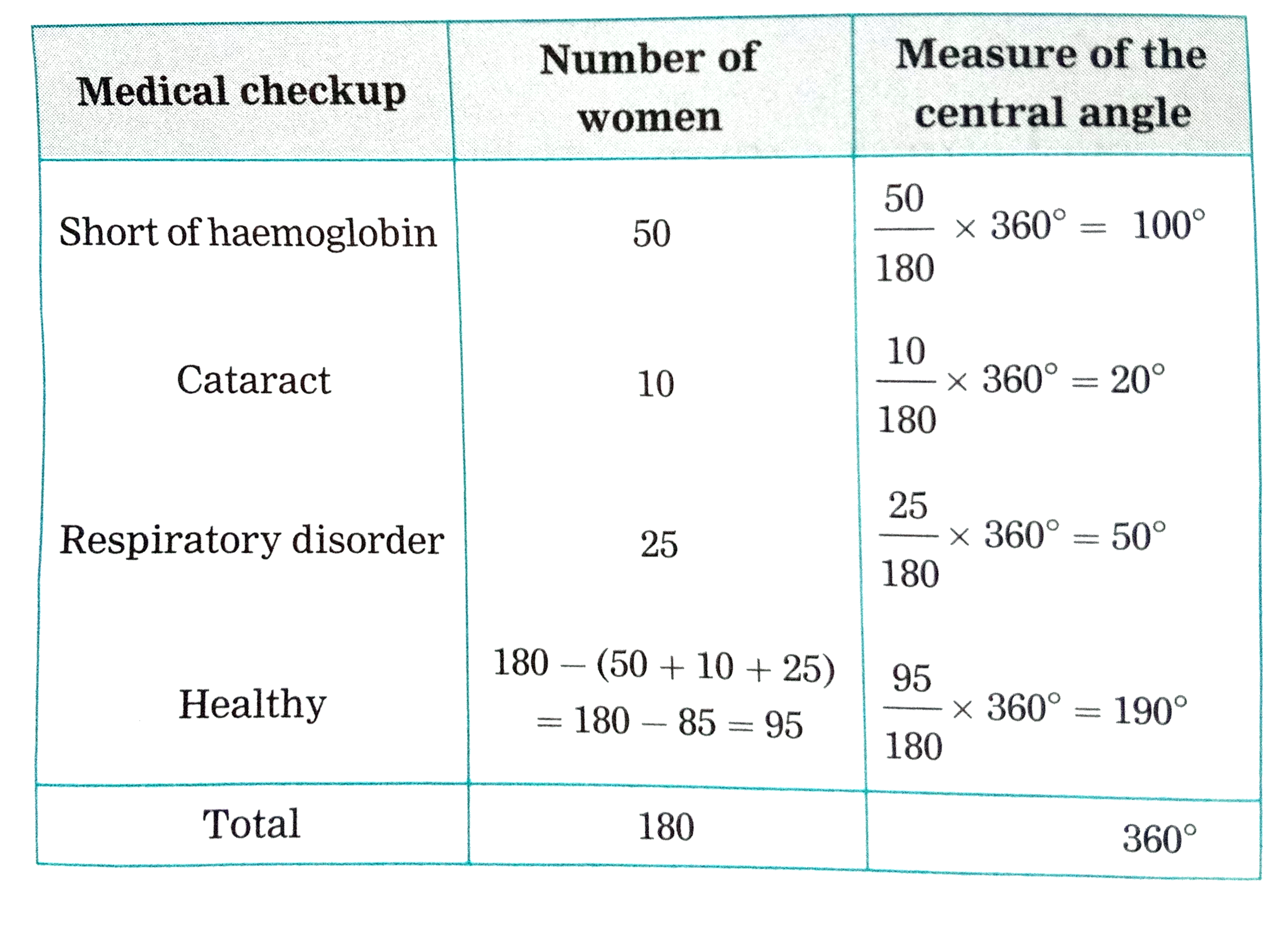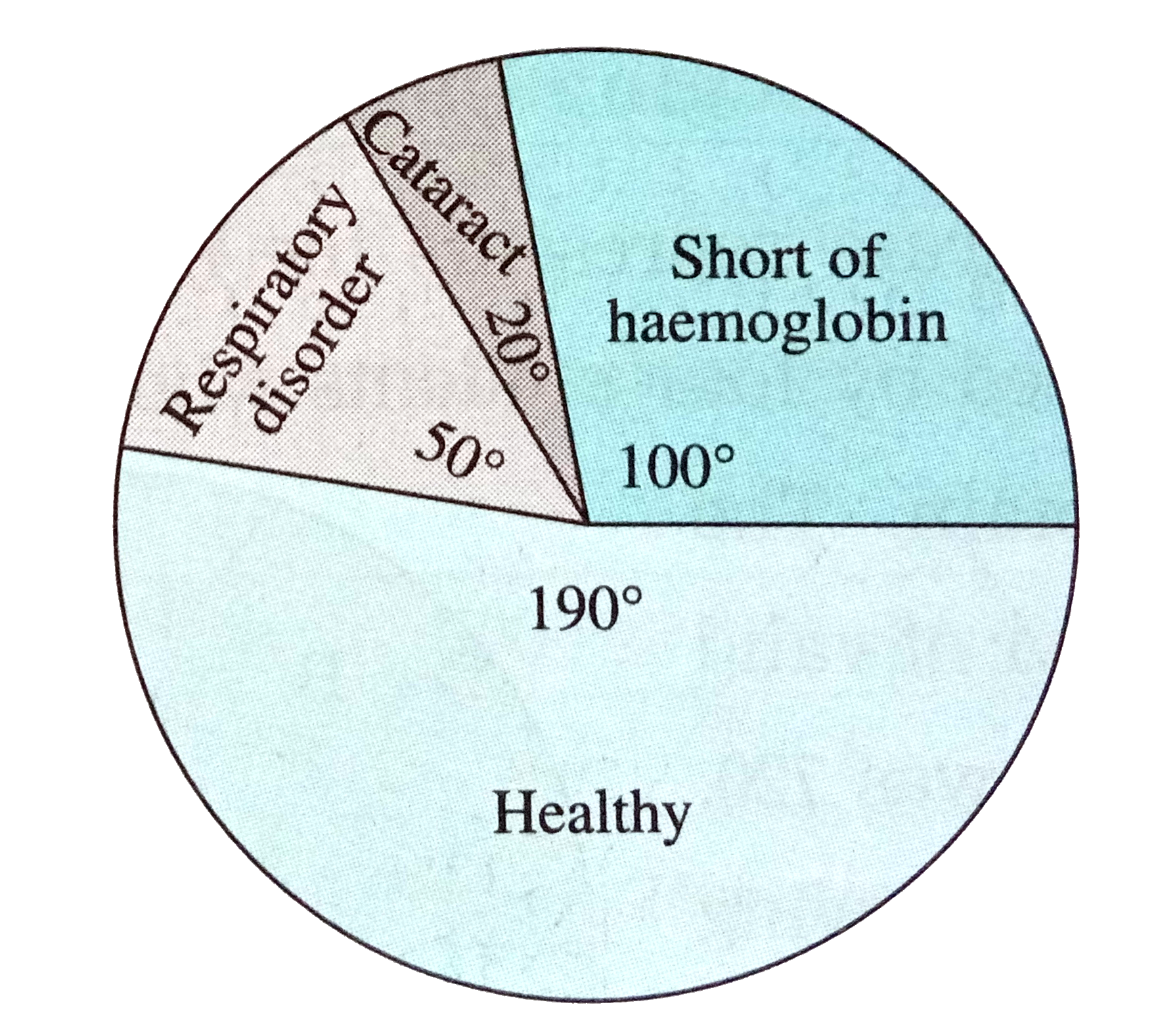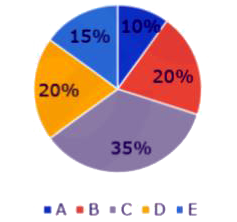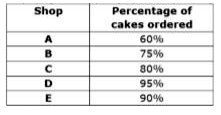Medical checkup of 180 women was conducted in a health centre in a village. 50 of them were short of haemoglobin , 10 suffered from catarect and 25 had respiratory disorders. The remaining women were healthy. Show the information by a pie diagram.
Let us prepare a table showing the measure of central angle for the diseases.


Topper's Solved these Questions
- BOOK - NAVNEET PUBLICATION - MAHARASHTRA BOARDCHAPTER - STATISTICSEXERCISE - PRACTICE SET 6.16videos
STATISTICS
- BOOK - NAVNEET PUBLICATION - MAHARASHTRA BOARDCHAPTER - STATISTICSEXERCISE - PRACTICE SET 6.24videos
STATISTICS
- BOOK - NAVNEET PUBLICATION - MAHARASHTRA BOARDCHAPTER - STATISTICSEXERCISE - EXAMPLES3videos
STATISTICS
- BOOK - NAVNEET PUBLICATION - MAHARASHTRA BOARDCHAPTER - SIMILARITYEXERCISE - SUBJECTIVE TYPE20videos
SIMILARITY
- BOOK - NAVNEET PUBLICATION - MAHARASHTRA BOARDCHAPTER - THEOREMS EXERCISE - CIRCLE15videos
THEOREMS
Similar Questions
The Roman Empire covered a vast stretch of territory that included most of Europe as we know it today and a large part o f the Fertile Crescent and North Africa. The Roman empire embraced a wealth of local cultures and languages, that women had a stronger legal position then than they do in many countries today, but also that much of the the economy was run on slave l abour, denying freedom to substantial numbers of persons. From the fifth century onwards, the empire fell apart in the west but remained intact and exceptionally prosperous in its eastern half. Roman historians have a rich collection of sources to go on, which we can broadly divide into three groups: (a) texts, (b) documents and (c) material remains. Textual sources i nclude letters, speeches, sermons, laws, and histories of the period written by contemporaries. These were usually called ‘Annals’ because the narrative was constructed on a year-by-year basis. Documentary sources include mainly inscriptions and papyri. Inscriptions were usually cut on stone, so a large number survive, in both Greek and Latin. The ‘papyrus’ was a reed l ike plant that grew along the banks of the Nile in Egypt and was processed to produce sheets of writing material that was very widely used in everyday life. Thousands of contracts, accounts, letters and official documents survive ‘on papyrus’ and have been published by scholars who are called ‘papyrologists’. Material remains include a very wide assortment of items that mainly archaeologists d iscover (for example, through excavation and field survey), for example, buildings, monuments and other kinds of structures, pottery, coins, mosaics, even entire l andscapes. Each of these sources can only tell us just so much about the past, and combining them can be a fruitful exercise, but how well this is done d epends on the historian’s skill!
Who were papyrologists?View SolutionRead the following passages and answer the questions given after them.
PASSAGE - II
The Roman Empire covered a vast stretch of territory that included most of Europe as we know it today and a large part of the Fertile Crescent and North Africa.
The Roman Empire embraced a wealth of local cultures and languages, that women had a stronger legal position then than they do in many countries today, but also that much of the economy was run on slave labour, denying freedom to substantial numbers of persons! From the fifth century onwards, the empire fell apart in the west but remained intact and exceptionally prosperous in its eastern half.
Roman historians have a rich collection of sources to go on, which we can broadly divide into three groups: (a) texts, (b) documents and (c) material remains. Textual sources include letters, speeches, sermons, laws, and histories of the period written by contemporaries. These were usually called .Annals. because the narrative was constructed on a year-by-year basis. Documentary sources include mainly inscriptions and papyri. Inscriptions were usually cut on stone, so a large number survive, in both Greek and Latin. The .papyrus. was a reedlike plant that grew along the banks of the Nile in Egypt and was processed to produce sheets of writing material that was very widely used in everyday life. Thousands of contracts, accounts, letters and official documents survive .on papyrus. and have been published by scholars who are called .papyrologists.. Material remains include a very wide assortment of items that mainly archaeologists discover (for example, through excavation and field survey), for example, buildings, monuments and other kinds of structures, pottery, coins, mosaics, even entire landscapes. Each of these sources can only tell us just so much about the past, and combining them can be a fruitful exercise, but how well this is done depends on the historian.s skill!
Which of these are NOT material remains?View Solution
Knowledge Check
- Question 1 - Select One or More
Medical checkup of women was conducted at a health centre in a village. The number of women suffering from respireatory disorders was presented in a pie diagram by the central angle 54∘. What is the percentage of these woman of the total number of women?
A0.25B0.2C0.15D0.1 - Question 2 - Select One
Study the given information carefully and answer the questions that follow.
The given below graph shows the percentage distribution of the number of cakes baked by 5 shops (A, B, C, D and E) on a given day. Total number of cakes baked by the 5 shops were 400.

The given below table shows the percentage of cakes ordered from the five shops out of the baked cakes.

Note:
Number of cakes unsold = Number of cakes baked - Number of cakes ordered
All the ordered cakes are to be considered as cakes sold.
The number of cakes that were unsold from shops A, B and C, 25 % were given to the beggars. Of the remaining, 25 % were eaten by the staff of the shops while the rest were sold the next day at 10% loss. If, each cake costed Rs. 250 to bake for all the shops, what was the total amount earned from these cakes?ARs. 7800BRs. 8400CRs. 9450DRs. 8100 - Question 3 - Select One
Read the following passages and answer the questions given after them.
PASSAGE - II
The Roman Empire covered a vast stretch of territory that included most of Europe as we know it today and a large part of the Fertile Crescent and North Africa.
The Roman Empire embraced a wealth of local cultures and languages, that women had a stronger legal position then than they do in many countries today, but also that much of the economy was run on slave labour, denying freedom to substantial numbers of persons! From the fifth century onwards, the empire fell apart in the west but remained intact and exceptionally prosperous in its eastern half.
Roman historians have a rich collection of sources to go on, which we can broadly divide into three groups: (a) texts, (b) documents and (c) material remains. Textual sources include letters, speeches, sermons, laws, and histories of the period written by contemporaries. These were usually called .Annals. because the narrative was constructed on a year-by-year basis. Documentary sources include mainly inscriptions and papyri. Inscriptions were usually cut on stone, so a large number survive, in both Greek and Latin. The .papyrus. was a reedlike plant that grew along the banks of the Nile in Egypt and was processed to produce sheets of writing material that was very widely used in everyday life. Thousands of contracts, accounts, letters and official documents survive .on papyrus. and have been published by scholars who are called .papyrologists.. Material remains include a very wide assortment of items that mainly archaeologists discover (for example, through excavation and field survey), for example, buildings, monuments and other kinds of structures, pottery, coins, mosaics, even entire landscapes. Each of these sources can only tell us just so much about the past, and combining them can be a fruitful exercise, but how well this is done depends on the historian.s skill!
Who were papyrologists?APeople who processed papyrus into sheetsBScholars who published documentsCFarmers who cultivated papyrusDPeople who surveyed the reed like plants along the Nile
Read the following passages and answer the questions given after them.
PASSAGE - II
The Roman Empire covered a vast stretch of territory that included most of Europe as we know it today and a large part of the Fertile Crescent and North Africa.
The Roman Empire embraced a wealth of local cultures and languages, that women had a stronger legal position then than they do in many countries today, but also that much of the economy was run on slave labour, denying freedom to substantial numbers of persons! From the fifth century onwards, the empire fell apart in the west but remained intact and exceptionally prosperous in its eastern half.
Roman historians have a rich collection of sources to go on, which we can broadly divide into three groups: (a) texts, (b) documents and (c) material remains. Textual sources include letters, speeches, sermons, laws, and histories of the period written by contemporaries. These were usually called .Annals. because the narrative was constructed on a year-by-year basis. Documentary sources include mainly inscriptions and papyri. Inscriptions were usually cut on stone, so a large number survive, in both Greek and Latin. The .papyrus. was a reedlike plant that grew along the banks of the Nile in Egypt and was processed to produce sheets of writing material that was very widely used in everyday life. Thousands of contracts, accounts, letters and official documents survive .on papyrus. and have been published by scholars who are called .papyrologists.. Material remains include a very wide assortment of items that mainly archaeologists discover (for example, through excavation and field survey), for example, buildings, monuments and other kinds of structures, pottery, coins, mosaics, even entire landscapes. Each of these sources can only tell us just so much about the past, and combining them can be a fruitful exercise, but how well this is done depends on the historian.s skill!
Documentary sources of the history of Roman Empire includeView SolutionRead the following passages and answer the questions given after them.
PASSAGE - II
The Roman Empire covered a vast stretch of territory that included most of Europe as we know it today and a large part of the Fertile Crescent and North Africa.
The Roman Empire embraced a wealth of local cultures and languages, that women had a stronger legal position then than they do in many countries today, but also that much of the economy was run on slave labour, denying freedom to substantial numbers of persons! From the fifth century onwards, the empire fell apart in the west but remained intact and exceptionally prosperous in its eastern half.
Roman historians have a rich collection of sources to go on, which we can broadly divide into three groups: (a) texts, (b) documents and (c) material remains. Textual sources include letters, speeches, sermons, laws, and histories of the period written by contemporaries. These were usually called .Annals. because the narrative was constructed on a year-by-year basis. Documentary sources include mainly inscriptions and papyri. Inscriptions were usually cut on stone, so a large number survive, in both Greek and Latin. The .papyrus. was a reedlike plant that grew along the banks of the Nile in Egypt and was processed to produce sheets of writing material that was very widely used in everyday life. Thousands of contracts, accounts, letters and official documents survive .on papyrus. and have been published by scholars who are called .papyrologists.. Material remains include a very wide assortment of items that mainly archaeologists discover (for example, through excavation and field survey), for example, buildings, monuments and other kinds of structures, pottery, coins, mosaics, even entire landscapes. Each of these sources can only tell us just so much about the past, and combining them can be a fruitful exercise, but how well this is done depends on the historian.s skill!
Much of the economy in the Roman Empire was run onView SolutionRead the following passages and answer the questions given after them.
PASSAGE - II
The Roman Empire covered a vast stretch of territory that included most of Europe as we know it today and a large part of the Fertile Crescent and North Africa.
The Roman Empire embraced a wealth of local cultures and languages, that women had a stronger legal position then than they do in many countries today, but also that much of the economy was run on slave labour, denying freedom to substantial numbers of persons! From the fifth century onwards, the empire fell apart in the west but remained intact and exceptionally prosperous in its eastern half.
Roman historians have a rich collection of sources to go on, which we can broadly divide into three groups: (a) texts, (b) documents and (c) material remains. Textual sources include letters, speeches, sermons, laws, and histories of the period written by contemporaries. These were usually called .Annals. because the narrative was constructed on a year-by-year basis. Documentary sources include mainly inscriptions and papyri. Inscriptions were usually cut on stone, so a large number survive, in both Greek and Latin. The .papyrus. was a reedlike plant that grew along the banks of the Nile in Egypt and was processed to produce sheets of writing material that was very widely used in everyday life. Thousands of contracts, accounts, letters and official documents survive .on papyrus. and have been published by scholars who are called .papyrologists.. Material remains include a very wide assortment of items that mainly archaeologists discover (for example, through excavation and field survey), for example, buildings, monuments and other kinds of structures, pottery, coins, mosaics, even entire landscapes. Each of these sources can only tell us just so much about the past, and combining them can be a fruitful exercise, but how well this is done depends on the historian.s skill!
Which of these statements is NOT true?View SolutionRead the passage given below and answer the questions that follow by choosing the correct/most appropriate options:
On an ordinary workday, 27 year old Pramila Bariki hikes up_steep slopes across fields, through ankle-deep rivulets, often walking upto 14 kms. She gets a ride until the road is motoráble, from which point she has to walk.
Her job? She doles out healthcare advice to mothers and children in the remotest hamlets in the Araku valley of Andhra Pradesh.
Now heayily pregnant Pramila las had to slow down delegating-fasks to Duridi, Neeraj, Sunita and others. It's they who now walk throughi forests and climb up moutains, visiting families to identify pregnant women and conduct basic tests for diabetes and anaemia and connect them with a primary health centre, whenever necessary. These'young tribal women arejall trained auxiliary puises, part of an experimental-health project in Araku that aims to end preventable deaths during childbirth or infancy.
The Araku valley is home to several nomadic tribes who live in small clusters of 70 to 150 homes situated in rugged and inaccessible terrain. Until a few years ago these communities: were unaware of government healthcare l'policies. The death of a child or a woman during pregnancy or childbirth was connon and they were resigned to it
Today 38 women like Pramila drawn from these tribes, have broken social and cultural barriers to train as nurses and provide medical care to 1179 hamlets across the Araku, Paderu and Chintapalli mandals. Since they are from these cominunities they have been able create trust in the families and neighbours about formal healthcare. As a result these remote villages have now had the first childbirth in hospital, the first delivery by a trained nurse and the first mother not to lose a child.
The nurses advise women on hygiene and nutrition and convince them to visit the nearest health centre for further check-ups.
Read the following statements:
A. Child mortality rate in the tribal areas was very high in the past
B. Pramila and her colleagues are rendering invaluable services to the tribal women.View SolutionRead the passage given below and answer the questions that follow by choosing the correct/most appropriate options:
On an ordinary workday, 27 year old Pramila Bariki hikes up_steep slopes across fields, through ankle-deep rivulets, often walking upto 14 kms. She gets a ride until the road is motoráble, from which point she has to walk.
Her job? She doles out healthcare advice to mothers and children in the remotest hamlets in the Araku valley of Andhra Pradesh.
Now heayily pregnant Pramila las had to slow down delegating-fasks to Duridi, Neeraj, Sunita and others. It's they who now walk throughi forests and climb up moutains, visiting families to identify pregnant women and conduct basic tests for diabetes and anaemia and connect them with a primary health centre, whenever necessary. These'young tribal women arejall trained auxiliary puises, part of an experimental-health project in Araku that aims to end preventable deaths during childbirth or infancy.
The Araku valley is home to several nomadic tribes who live in small clusters of 70 to 150 homes situated in rugged and inaccessible terrain. Until a few years ago these communities: were unaware of government healthcare l'policies. The death of a child or a woman during pregnancy or childbirth was connon and they were resigned to it
Today 38 women like Pramila drawn from these tribes, have broken social and cultural barriers to train as nurses and provide medical care to 1179 hamlets across the Araku, Paderu and Chintapalli mandals. Since they are from these cominunities they have been able create trust in the families and neighbours about formal healthcare. As a result these remote villages have now had the first childbirth in hospital, the first delivery by a trained nurse and the first mother not to lose a child.
The nurses advise women on hygiene and nutrition and convince them to visit the nearest health centre for further check-ups.
The tribal people trust the health workers mostly because they:View Solution

